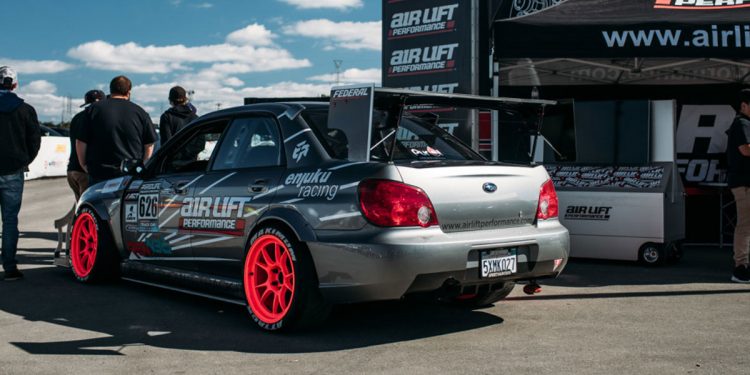When it comes to high-performance cars built to handle well, the general thought of many enthusiasts is that you need coilover suspension. With coilovers, you have the ability to change your spring rates, ride height, and dampening, which allows you to fine tune how it handles. Generally speaking, a coilover suspension is the choice of enthusiasts who want to hit the track or canyon road.
There is a generally assumption that air ride suspension is only for people who want stance and don’t care about handling, but this couldn’t be further from the truth. In this short article, we’re going to dive into air suspension and explain how it can be used for more than just stance.
How is Air Suspension Different From Coilovers?
Before we dive into how air suspension can handle as well as coilovers, it’s important to cover what air suspension is briefly. Many modern cars use a MacPherson style suspension with a coilover, even cars with other suspension styles use coilovers. Now, take that coilover, remove the coil spring and replace it with an airbag, and you have air suspension. It’s just like a coilover, but with an airbag instead of a coil spring.
In cars where the spring and shock are separate, the airbag would simply replace the coil spring. On many air suspension systems, the strut is height adjustable separate from the airbag which allows you to dial in air pressure without raising the ride height.
Is It Adjustable?
Adjustability depends on the air suspension kit you decide to purchase, but on many air suspension systems, you will have some dampening adjustment. This allows you to control compression and rebound speed, which is critical to good ride quality and well-controlled body movement. As mentioned above, the air strut is also often height adjustable like a traditional coilover would be.
The big benefit to air suspension is being able to adjust ride height on the fly by either increasing or decreasing air pressure on the fly. As you’d expect increasing or decreasing air pressure will change ride height. When you’re setting up what air pressure you would like to use at the standard ride height, you will need to adjust the height of the air strut to get the stance at ride height you want.
Is the Effective Spring Rate High Enough for Track Usage?
You might be thinking since you’re cramming tons of air pressure into an airbag, there is a limit to how much air can be added before something fails, and that the limit might make the system have a low spring rate. Luckily, this is not the case.
Pressure can be set high enough to work perfectly with a high grip car with lots of aero just fine. Unless you’re trying to install an air suspension system on an F1 car, the effective spring rate range should be plenty high enough for any road or track needs.
Is It Bouncy?
With pretty much any suspension system, the culprit of a bouncy ride is almost always poor dampening. An underdamped or over-damped system will ride terrible. As mentioned above, many air suspension kits such as kits from Air Lift Performance, have single adjustable dampers. So, unless you adjusted your dampening improperly, no it is not bouncy.
What About Cost?
If you’re the type of enthusiast who thinks you can get a super high-quality coilover suspension system for your car for under $1,000, then yes, air suspension might seem expensive. As many track enthusiasts know, you get what you pay for. There is a reason that track rats are willing to spend upwards of $6,000 or more on a suspension system. All in for an Air Lift Performance kit, for example, you’re looking at around $2,000 – $3,000.
So, yes it is more expensive than low-end coilovers, but it’s around the same cost as many mid-to-high quality coilover systems.
So, Can it Handle?
To put it simply, yes. There is really nothing about modern air suspension systems that will hold them back from performing as good as a coilover system. The real reason air suspension has become a popular option for general performance use the preconceived notion that it’s only for show cars. Is it going to be a viable option for a full-blown race car? Well, it depends.
There are plenty of racers out there running air suspension on their car, such as Cody Miles who races time attack with his Subaru STI with an off-the-shelf Air Lift Performance Kit. If you’re racing a Formula car, for example, the added weight could offset the potential benefits, but for 99% of enthusiasts who track their car, even at the elite level, air suspension is a perfectly viable option.
If you have any questions about the Air Lift suspension systems or would like to purchase parts for your car, please do not hesitate to contact us. We can be reached by phone at 1.480.966.3040 or via email at sales@vividracing.com.





hello Bryce, like all the other that email you I am looking to move into bagging my 2020 Camaro SS 1le, for stance and performance purposes, and its pretty bad ass to pull up and let the air out.. So, my concerns are what system should I go with for durability and handling purposes as I am looking to track my vehicle and drive the car about three times a week for cruise ins. maybe a top 5 pic would be helpful to start my research. also im not to worried about a ruff ride
Please email our sales professionals at sales@vividracing.com and they would be more than happy to provide a list that they personally recommend.